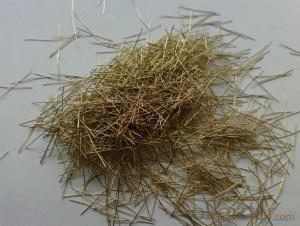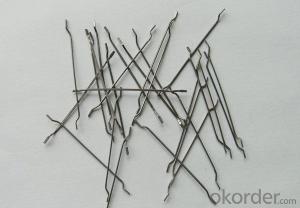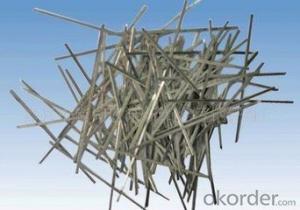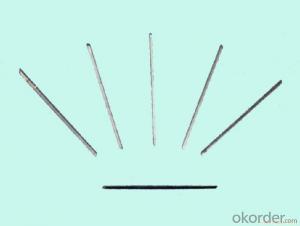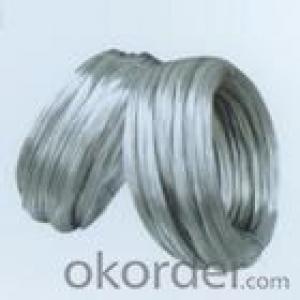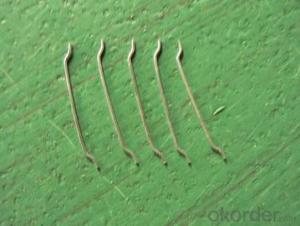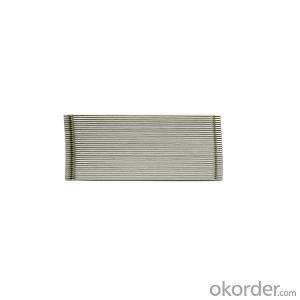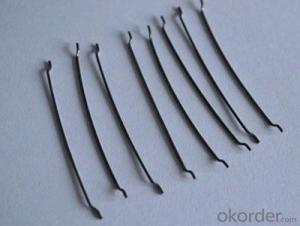Steel Fiber Loose concrete reinforcement Glued Concrete Reinforcement
- Loading Port:
- Tianjin
- Payment Terms:
- TT OR LC
- Min Order Qty:
- 5 kg
- Supply Capability:
- 30000 kg/month
OKorder Service Pledge
OKorder Financial Service
You Might Also Like
Quick Details
| Place of Origin: | Shandong, China (Mainland) | Brand Name: | cnbm | Material: | Steel |
| MATERIAL: | LOW CARBON STEEL WIRE | APPLICATION: | CONCRETE REINFORCED | STANDARD: | ISO9001 ASTM A820 |
| TYPE: | GLUED STEEL FIBER |
Specifications
Glued hooked steel fiber: Glueding single hooked steel fiber one by one in line with water soluble glue to keep the steel fibers evenly dispersed, no gobbet
Low carbon steel fiber for building construction
1.Diameter:0.4mm-1.2mm
2.Length: 25mm-60mm
3.Material: low carbon steel wire
4.Feature: 1100Mpa , excellent tensile,high tenacity,against cracking,impact and fatigue
5.Uses: highway road surface,tunnel,building,airport road surface and so on .
Picture
Steel fiber
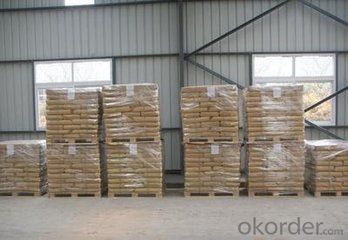
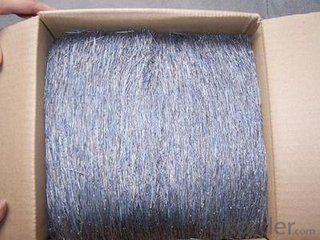
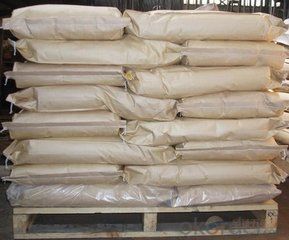
FAQ
certificated: ISO 9001
Technical advantages of Daye steel fiber:
A. Improve mechanical performance of concrete
B. Provide uniform distribution throughout concrete with excellent mixing
C. No balling or caking by adopt correct mixing method
D. Reduce concrete volume
E.Save construction time and cost
F.Reduce excavation volume
G.Available for jointless floor.
- Q:What is the recommended fiber content when using melt extract stainless steel fiber in concrete?
- The recommended fiber content when using melt extract stainless steel fiber in concrete is typically around 1-2% by volume.
- Q:Can melt extract stainless steel fiber be used in industrial flooring applications for shotcrete?
- Melt extract stainless steel fiber is a suitable option for shotcrete applications in industrial flooring. Shotcrete is a construction method that involves spraying concrete onto a surface using air pressure, resulting in a fast and efficient way to create a strong and durable floor. By incorporating stainless steel fiber into the shotcrete mix, the overall performance and durability of the flooring system can be enhanced. To produce melt extract stainless steel fiber, stainless steel is melted and then rapidly extracted into fine fibers. These fibers are known for their high tensile strength, resistance to corrosion, and toughness. When added to shotcrete, they contribute to improved crack resistance, impact resistance, and overall durability of the floor. In industrial environments where floors are subjected to heavy loads, impacts, and abrasion, using stainless steel fiber in shotcrete can offer significant advantages. It helps to minimize cracking, enhance resistance to wear and tear, and extend the lifespan of the floor. Moreover, stainless steel fiber can augment the fire resistance of shotcrete flooring, making it appropriate for industrial settings where fire safety is a concern. Overall, melt extract stainless steel fiber is an excellent choice for shotcrete applications in industrial flooring. It provides enhanced performance, durability, and fire resistance, making it a dependable solution for industrial settings that require robust and long-lasting flooring.
- Q:Can melt extract stainless steel fiber be used in tunnel lining rehabilitation applications?
- Melt extract stainless steel fiber is applicable for tunnel lining rehabilitation purposes. Known for their high strength, corrosion resistance, and durability, stainless steel fibers are suitable for various construction and rehabilitation projects. By incorporating these fibers into the concrete mix for tunnel lining rehabilitation, the mechanical properties of the concrete can be enhanced, and its resistance to cracking and spalling can be improved. The addition of stainless steel fibers increases the flexural strength of the concrete, reduces shrinkage, and enhances its overall durability. Moreover, these fibers also provide extra reinforcement to the tunnel lining, enhancing its resistance to seismic activity and other external forces. Ultimately, the utilization of melt extract stainless steel fiber in tunnel lining rehabilitation can extend the lifespan of the tunnel, improve its structural integrity, and minimize the need for frequent maintenance and repairs.
- Q:What is the impact of melt extract stainless steel fiber on the shrinkage of concrete?
- The shrinkage of concrete can be significantly affected by the utilization of melt extract stainless steel fiber. To strengthen the concrete and prevent cracking, stainless steel fibers are commonly added to concrete mixes. During the curing process, concrete tends to shrink as water evaporates, leading to cracks and decreased structural durability. However, the inclusion of melt extract stainless steel fibers in the concrete mix effectively controls and minimizes shrinkage. These stainless steel fibers act as reinforcement within the concrete, promoting a more even distribution of stress and strain. This reinforcement restrains concrete shrinkage and provides greater resistance against cracking. The enhanced tensile strength of the concrete also limits overall shrinkage, resulting in a stronger and longer-lasting structure. Furthermore, the melt extract stainless steel fibers possess high corrosion resistance, further enhancing their effectiveness in mitigating shrinkage. This corrosion resistance ensures the fibers maintain their structural integrity over time, even in harsh environmental conditions. Overall, the integration of melt extract stainless steel fibers in concrete significantly reduces shrinkage and improves the material's overall performance. By minimizing cracking and enhancing durability, structures constructed with this type of concrete exhibit a longer lifespan and require less maintenance.
- Q:Can melt extract stainless steel fiber be used in refractory applications?
- Melt extract stainless steel fiber can absolutely be utilized in refractory applications. Renowned for their exceptional mechanical properties and resistance to high temperatures, stainless steel fibers prove themselves as suitable candidates for inclusion in refractory materials. By incorporating these fibers, the strength, thermal shock resistance, and overall performance of refractory products can be significantly improved. They are widely applied in various scenarios, including furnace linings, kiln furniture, and thermal insulation. The melt extract process guarantees a consistent composition and structure of the stainless steel fibers, thereby enhancing their performance and durability in high-temperature environments. In summary, melt extract stainless steel fiber serves as a valuable addition to refractory materials, offering enhanced thermal and mechanical properties.
- Q:Can melt extract stainless steel fiber be used in lightweight aggregate concrete wall panels?
- Yes, melt extract stainless steel fiber can be used in lightweight aggregate concrete wall panels. Stainless steel fibers are commonly used as reinforcement in concrete to enhance its tensile strength, crack resistance, and durability. Lightweight aggregate concrete, which is made by replacing traditional coarse aggregate with lightweight materials such as expanded clay or shale, offers several advantages including lower dead load, better thermal insulation, and improved fire resistance. By incorporating melt extract stainless steel fibers into lightweight aggregate concrete, the resulting wall panels can benefit from the additional reinforcement provided by the fibers. This reinforcement helps to prevent cracking and improve the overall structural integrity of the panels. Additionally, stainless steel fibers are corrosion-resistant, which is crucial for applications in concrete exposed to harsh environments or moisture. The use of melt extract stainless steel fibers in lightweight aggregate concrete wall panels can also enhance their resistance to impact and blast loads, making them suitable for applications in areas prone to earthquakes or explosions. Furthermore, the addition of stainless steel fibers can improve the ductility and flexural strength of the panels, allowing them to better withstand external forces and deformations. Overall, melt extract stainless steel fibers can be successfully used in lightweight aggregate concrete wall panels to enhance their mechanical properties, durability, and performance in various applications.
- Q:Can melt extract stainless steel fiber be used in nuclear power plant applications?
- Yes, melt extract stainless steel fiber can be used in nuclear power plant applications. Its high melting point, corrosion resistance, and mechanical strength make it suitable for various applications in nuclear power plants, such as reinforcement in concrete structures, thermal insulation, and as a reinforcement material in high-temperature applications.
- Q:What are the environmental benefits of using melt extract stainless steel fiber in concrete?
- Using melt extract stainless steel fiber in concrete presents various environmental advantages. To begin with, stainless steel is an incredibly durable material renowned for its long lifespan. By incorporating stainless steel fibers into concrete, the overall durability and lifespan of the concrete structure are enhanced. Consequently, less concrete will need to be manufactured and replaced over time, resulting in decreased resource consumption and waste generation. Furthermore, the utilization of stainless steel fibers can bolster the structural integrity of concrete, allowing for reduced thickness and weight of concrete structures. Consequently, the amount of concrete required for construction projects is diminished, resulting in lower carbon emissions associated with concrete production. Additionally, stainless steel fibers can improve the crack resistance and impact resistance of concrete, minimizing the necessity for frequent repairs or replacements. As a result, maintenance and repair activities are reduced, leading to lower energy consumption and waste generation related to concrete upkeep. Moreover, the incorporation of stainless steel fibers in concrete can enhance its resistance to corrosion and chemical attack, thereby increasing its lifespan in harsh environments. This decreases the need for premature demolition and reconstruction, resulting in less waste generation and resource consumption. Lastly, stainless steel is a recyclable material that can be reused after reaching the end of its useful life. This means that the stainless steel fibers used in concrete can be recovered and recycled, reducing the demand for new stainless steel production and minimizing the environmental impact associated with its extraction and manufacturing processes. In conclusion, the use of melt extract stainless steel fiber in concrete offers numerous environmental benefits, including reduced resource consumption, lower carbon emissions, decreased waste generation, and increased recyclability.
- Q:What is the lifespan of concrete reinforced with melt extract stainless steel fiber?
- The lifespan of concrete reinforced with melt extract stainless steel fiber may vary based on multiple factors, including environmental conditions, material quality, and maintenance practices. Nonetheless, compared to traditional concrete, the use of melt extract stainless steel fiber reinforcement has the potential to significantly increase the structure's lifespan. Melt extract stainless steel fiber is renowned for its high tensile strength, corrosion resistance, and durability. These attributes make it an exceptional reinforcement material for concrete, augmenting its overall strength and ability to withstand cracking and deterioration. When incorporated into concrete, melt extract stainless steel fiber forms a robust network throughout the structure, providing additional reinforcement and impeding crack propagation. This greatly enhances the concrete's lifespan by reducing the risk of structural failure and bolstering its resistance to environmental factors like freeze-thaw cycles, chemical exposure, and abrasion. While the precise lifespan of concrete reinforced with melt extract stainless steel fiber cannot be determined without considering specific project details, it is generally expected to surpass that of traditional concrete structures. Implementing proper construction practices, such as thorough curing and quality control, in addition to regular maintenance and repairs, can further extend the lifespan of the reinforced concrete. It is important to acknowledge that the lifespan of any concrete structure, including those reinforced with melt extract stainless steel fiber, can be influenced by external factors like extreme weather conditions, improper usage, and lack of maintenance. Regular inspections, maintenance, and timely repairs are key to ensuring the structure's longevity and maximizing the benefits of utilizing melt extract stainless steel fiber reinforcement.
- Q:How does melt extract stainless steel fiber improve the crack width control in concrete?
- Melt extract stainless steel fiber improves crack width control in concrete by effectively reducing the propagation of cracks. The inclusion of these fibers in the concrete matrix enhances its tensile strength and ductility, making it more resistant to cracking. As a result, when cracks do occur, they tend to be narrower and less severe, thus preventing the spread of cracks and increasing the overall durability and performance of the concrete structure.
1. Manufacturer Overview |
|
|---|---|
| Location | |
| Year Established | |
| Annual Output Value | |
| Main Markets | |
| Company Certifications | |
2. Manufacturer Certificates |
|
|---|---|
| a) Certification Name | |
| Range | |
| Reference | |
| Validity Period | |
3. Manufacturer Capability |
|
|---|---|
| a)Trade Capacity | |
| Nearest Port | |
| Export Percentage | |
| No.of Employees in Trade Department | |
| Language Spoken: | |
| b)Factory Information | |
| Factory Size: | |
| No. of Production Lines | |
| Contract Manufacturing | |
| Product Price Range | |
Send your message to us
Steel Fiber Loose concrete reinforcement Glued Concrete Reinforcement
- Loading Port:
- Tianjin
- Payment Terms:
- TT OR LC
- Min Order Qty:
- 5 kg
- Supply Capability:
- 30000 kg/month
OKorder Service Pledge
OKorder Financial Service
Similar products
New products
Hot products
Hot Searches
Related keywords
